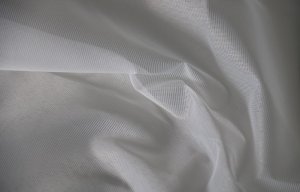
Karl Mayer steps up its operations in home textiles
New Weft Fashion TM3 patterns demonstrate the variety of decorative yarns that can be used.
7th June 2021
Knitting Industry
|
Obertshausen, Germany
Karl Mayer’s Weft Fashion TM3 machine helps raise the productivity of the warp knitting mill, when producing curtain fabrics featuring the most popular woven-like looks. The design potential offered in this process is manifold, the company reports.
Karl Mayer’s textile developers had already started testing out the possibilities on the prototype. Initial work concentrated on the basic structure, while further trials looked at incorporating simple effect yarns as fully inserted wefts. The created samples – wafer-thin, extremely transparent and feather-light qualities with a basic organza structure and decorative thread covering the entire surface – were shown at Heimtextil in Frankfurt am Main in 2019 and were met with great interest.
In their latest project, Karl Mayer’s textile developers looked further into using effect yarns. They tested the processing of a total of 40 variants of different designs on a series machine that is now available in the market. Among other things, knots, burls, loops, graver hair, fringes, Lurex spots, mini sequins, twists and pleats made the thread material truly eye-catching in a full inlay. The gauge of the design threads was just as varied as their appearance. Heavier variants had thicknesses of up to dtex 5500, while the most delicate had a thickness of dtex 500.
Effect yarns
As the focus of the processing tests was on effect yarns, a simple pattern was chosen for the base fabric. Ground guide bar GB 1 ensures high longitudinal stability with a pillar stitch. GB 2 implements an inlay under two needles. This result is a voile-like, structurally stable fabric with a dense surface but sufficient transparency for a conventional curtain fabric. The discreet view through was achieved by using a machine gauge of E 24 and a heavy yarn gauge. Polyester dtex 50 f 24 was used in both ground guide bars.
All of the 36 decorative threads used could be easily integrated into this fabric base. Neither the machine speed nor the fabric appearance had to be compromised. “Even with variants where we had reservations, for example because of the yarn thickness or design, we reached our target of 1500 rpm on the machine,” says Jürgen Wohlrab from Karl Mayer’s Textile Technology Product Development department.
Perfect quality was also achieved by balancing the stitch density, yarn gauge and feed distance. Thin threads must be firmly bound into the ground by a higher number of stitches per cm. Otherwise they can just be pulled out, in Jürgen Wohlrab’s experience.
By contrast, thick, heavy and fluffy effect yarns require a low stitch density to prevent the pattern thread from pinching or even the basic structure from bursting. This correlation between stitch density and yarn gauge becomes less important as the number of weft threads per unit length decreases. During Karl Mayer’s processing tests, a decorative thread was registered approximately every 1.5 cm. In view of the large spacing, the stitch density – adjusted to 18 stitches/cm – could be kept constant.
Further design potential
Pattern yarns not only render sophisticated design effects possible thanks to their diverse constructions, but also by playing with the yarn tension during integration. For example, base fabrics with taut, fluffy variants can spring into place after being removed from the machine and thus form a striking crepe-like surface.
Jürgen Wohlrab wants to test this in further investigations. He also wants to use the patterning possibilities of three-bar tricot machines, which the Weft Fashion TM3 offers in principle, to design new base fabrics. It would be conceivable, for example, to produce textile structures with lengthwise stripes of varying density by using a mesh treading. Used crosswise, it could be used to create striking base curtains.
Through the targeted variation of threading, yarn selection and textile construction, it is also possible to open up applications beyond the curtain sector – for example, for upholstery and clothing, such as light blouses, dresses or trousers.
The Weft Fashion TM3 is an efficient tricot machine with course-oriented weft-insertion for producing medium-weight home textiles. The basic equipment includes three ground guide bars and a system for inserting up to 24 weft threads. These are delivered from a creel and laid across the entire working width. The guide bars are controlled by pattern disks.
The machine delivers an exceptional cost-to-benefit ratio, runs extremely reliably, and is easy to operate. It is available in a gauge of E 24 with a working width of 132”. Its product portfolio includes warp knitted curtains with incorporated effect yarns, maximum 3.25 m in length and imitating woven material. Unlike weaving, warp knitting does not require a sizing process, nor the corresponding use of water, chemicals or energy. Productivity is also excellent. On the Weft Fashion TM 3, depending on the fabric being produced, up to 60 m of curtain fabric can be produced per hour.

Business intelligence for the fibre, textiles and apparel industries: technologies, innovations, markets, investments, trade policy, sourcing, strategy...
Find out more